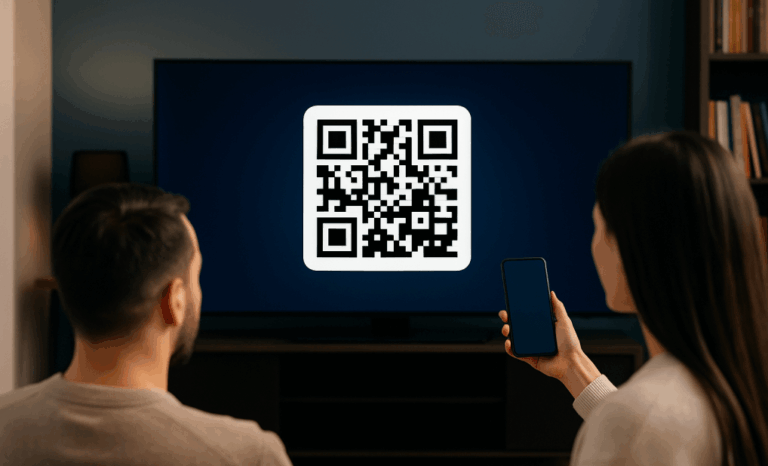Connecting television and smartphones
Television remains one of the most influential advertising channels, with TV commercials still reaching millions of viewers daily. But today, the living room looks different. Audiences no longer passively watch television ads — most people hold a mobile device while watching their favorite TV show. This dual-screen behavior opens up a massive opportunity: using TV QR codes to bridge offline and online interactions in real time.
A QR code on a TV screen transforms a fixed location medium into a dynamic entry point for engagement. Instead of expecting viewers to remember a website later, advertisers can place a floating QR code directly in a commercial, prompting immediate scans. A simple code on screen can connect viewers to a landing page, app download, or even a digital business card. The result is a powerful way to convert offline engagements into online conversions.
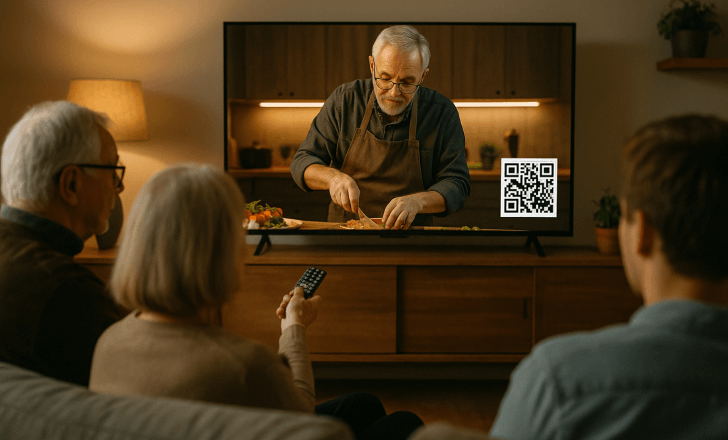
The shift from passive to interactive viewing
For decades, television ads functioned as one-way traffic. Brands spent heavily on tv commercials, but the best outcome they could hope for was brand recall. Viewers were expected to act later, usually by searching for a product or visiting a store. In today’s hyper-digital environment, that’s no longer enough.
By adding QR codes on TV, advertisers eliminate friction. Viewers don’t need to remember URLs or type long searches. A quick scan leads them directly to interactive content, app downloads, or special offers. A once-passive activity becomes a highly interactive experience. With dynamic QR codes, campaigns evolve from awareness drivers into measurable marketing strategies that deliver immediate action.
The convenience factor
Convenience is a key reason QR codes in TV advertising are exploding in popularity. Imagine this:
- You’re watching a car ad during your favorite TV program. A white QR code appears at the bottom of the television screen. With one scan, you can schedule a test drive.
- A cooking show displays a URL QR code. Scan it, and the recipe instantly appears on your mobile device.
- A streaming platform promo shows a dark background with a highly interactive code, letting you sign in or subscribe without typing a single character.
These digital interactions create an effortless and immersive experience for users while giving advertisers direct, measurable outcomes.
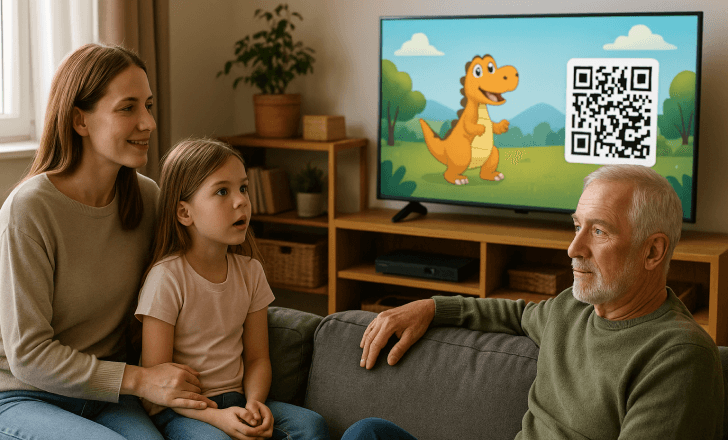
How brands and broadcasters benefit
TV QR codes are not just convenient; they’re an effective tool for maximizing engagement. For advertisers, they offer:
- In-depth analytics: Brands can see scan rates, user locations, devices used, and the exact time of interaction.
- Real-time insights: Instead of guessing the impact of a TV advertisement, scan data proves how many people acted.
- Maximum engagement: By encouraging viewers to scan, ads generate more digital interactions and better ROI.
Broadcasters also win. Integrating codes in TV commercials enhances relevance and future-proofs content. For audiences, QR codes feel natural, since they already use their phones constantly while watching.
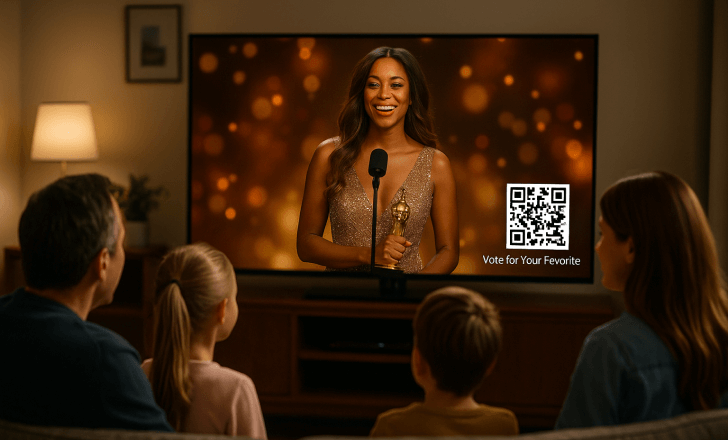
Creativity meets technology
The evolution from static to dynamic QR codes allows advertisers to do more than paste black squares on screen. With a QR code generator like QRCodeKIT, codes can be branded, colorful, and even artistic. Advertisers can match them to a show’s theme, add logos, or use custom frames with a compelling call to action.
This creativity is what makes QR codes work in a crowded media space. Whether it’s a white QR code on a dark background for maximum contrast, or a floating QR code that moves during a commercial, the ability to stand out matters. Today’s marketing campaigns rely on both functionality and design to demand attention.
Use cases for TV QR codes
The versatility of TV QR codes is what makes them such a versatile technology for both advertisers and viewers. Here are some of the most impactful applications:
Advertising campaigns
Placing a QR code in TV ads directs viewers to product pages, coupon codes, or promotional videos. The Burger King app campaign, for example, used a floating QR code in a commercial to drive downloads, proving how QR code campaigns can directly increase online conversions.
Streaming platforms
OTT platforms and streaming services rely on QR codes on TV to simplify sign-ins. Instead of entering long credentials on a TV screen, users scan and log in instantly. This method boosts scan rates and creates smoother digital interactions.
Live shows and events
Award shows, concerts, and sports broadcasts use television QR codes to let audiences vote, buy merchandise, or access behind-the-scenes footage. This transforms traditional television commercials into interactive content.
News and education
Broadcasters can add QR codes during news segments to redirect viewers to detailed reports, fact-checks, or explainer videos. This turns television ads into gateways for deeper learning without overwhelming the tv screen size.

Donations and fundraising
Telethons and nonprofits leverage QR codes in TV to simplify donations. A quick scan lets viewers give instantly, reducing barriers.
Gaming and entertainment
Interactive shows use codes in tv commercials to let people play along, vote on outcomes, or unlock bonuses. This keeps users engaged far beyond watching.
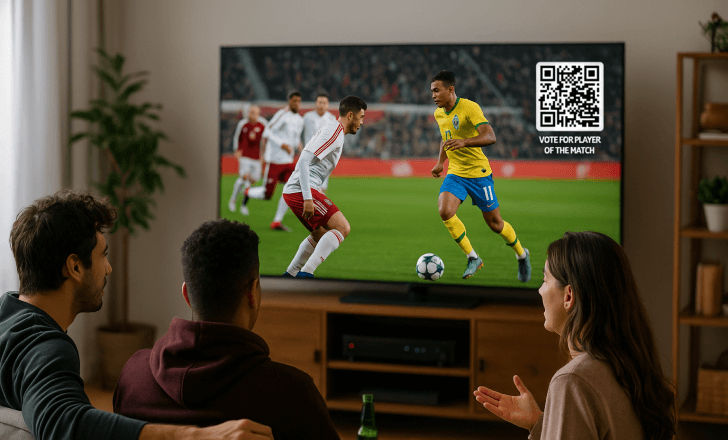
E-commerce and product launches
Brands launching new products on television ads can link QR codes directly to purchase pages. This removes steps between awareness and sales, driving users toward immediate action.
Travel and tourism
Tourism boards can run television commercials with QR codes linking to itineraries, videos, or booking sites. A scan converts inspiration into planned trips.
Fitness and wellness
Workout programs often use QR codes on TV to provide nutrition guides, app downloads, or exclusive content. This turns a fixed location (the living room) into an interactive fitness hub.
Government and public service
Authorities use QR codes during emergency broadcasts, helping citizens access instructions or resources instantly. A compelling call to action can even save lives.
The Burger King example and beyond
The most famous case of TV QR code marketing came from Burger King. During a campaign, a floating QR code appeared on-screen, bouncing around like the classic DVD logo. Curious viewers scanned it, unlocking free Whopper coupons through the Burger King app. This simple yet highly effective stunt showed how a white background code with playful movement could engage audiences at scale.
Other industries quickly followed. Financial services tested free bitcoin giveaways via TV QR codes. Entertainment brands used QR code campaigns in OTT platforms to unlock trailers. Each example demonstrates the same principle: when you meet viewers on their favorite TV shows, they respond with curiosity and action.

How to create TV QR codes with QRCodeKIT
With QRCodeKIT, creating and managing TV QR codes is simple:
- Generate dynamic QR codes that can be edited anytime — no need to re-shoot commercials.
- Create QR codes that redirect to websites, apps, videos, or landing pages.
- Customize codes with logos, colors, or branded frames.
- Download high-resolution codes that look sharp on large television screens.
- Track scans with analytics to see how many users connected via their mobile device.
Whether you want to boost website traffic, increase app downloads, or share a digital business card, QRCodeKIT gives you the tools to design, track, and optimize campaigns for maximum engagement.
Conclusion
TV QR codes are changing the way people watch television. By combining the reach of television ads with the immediacy of a QR code generator, brands can engage audiences in new, meaningful ways. From burger king’s iconic floating QR code to government messaging and e-commerce launches, the results speak for themselves: more scans, more data, and more conversions.
With QRCodeKIT, you can create TV QR codes that stand out, track performance with in-depth analytics, and ensure your next tv advertisement doesn’t just entertain but actively connects. The television screen is no longer just a broadcast tool — with the right QR code campaigns, it becomes a bridge to the digital world.
